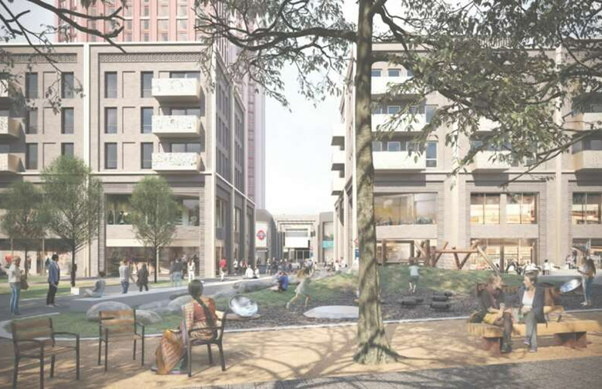The Government has published a technical consultation on the proposed Infrastructure Levy (‘the Levy’), another significant reform set out within the emerging Levelling Up and Regeneration Bill (‘the Bill’). The Levy is intended to replace developer contributions currently encompassed by Section 106 (S106) agreements and the Community Infrastructure Levy (CIL).
The current consultation is intended to influence the preparation and content of the regulations, which, once drafted, will be subject to further consultation. The proposals apply to England only, with the current consultation running for 3 months, concluding on 9th June 2023.
We have summarised the key headlines of this consultation below.
Current system
Developer contributions are utilised to mitigate the impacts of new development through the provision of essential infrastructure such as affordable housing, schools, GP surgeries, green spaces and transport infrastructure.
There are currently two routes which are front-loaded within the planning process:
– Planning Obligations: S106 agreements, negotiated with developers under S106 of the Town and Country Planning Act 1990.
– CIL: a fixed charge levied on the floorspace of a new development.
Planning obligations are, nevertheless, criticised as ‘uncertain and opaque’, often resulting in significant delays to the final granting of planning permission. CIL is discretionary in principle and still only around half of all Local Planning Authorities (LPA) charge CIL. The Government has thus taken the opportunity to devise a new system to “reconsider how value is captured from new development and to create a simpler, non-negotiable, and streamlined system that can capture more value and provide better outcomes for communities”.
The new system
Crucially, the new system will become a mandatory charge in England, meaning more development overall will be captured into the regime of developer contributions. The new Levy is presented as a more efficient and transparent system, intended to ensure developers pay a “fair share” for affordable housing and local infrastructure.
Another key difference is that the Levy will be charged at the end of the planning stage. This would involve the total fee being calculated once a project has been completed, as opposed to the current arrangement, whereby the amount is negotiated during the final determination of proposals. This amendment is designed to allow Councils to benefit from increases in land value. The consultation sets out that the Levy will be charged on the value of the property at completion per square metre and will be applied above a minimum threshold.
The Levy rates and minimum thresholds will also be locally determined by the charging authority, with Councils also able to set varying rates within their authoritative area; when setting their rate consideration must be given to factors including the viability of development within the area and the desirability that rates can deliver affordable housing at a level equalling or exceeding the current rate in that area.
Developers would therefore be able to price the value of contributions into the value of the land, while also enabling Levy liabilities to reflect market conditions, thereby removing the need for planning obligations to be renegotiated if the gross development value is lower than originally expected. On the other hand, this system would allow local authorities to benefit from the uplift if this value is higher than anticipated.
The current consultation makes it clear that Levy charging schedules will be subject to a process of examination in public prior to adoption. It is also noted that the Secretary of State for DLUHC can intervene in the preparation of charging schedules in certain circumstances.
Development, for the purposes of the Levy, is defined at Section 204E(1) in Schedule 11 of the Bill. This definition is noted within the current consultation as broad and covering the creation of new buildings and changes of use in existing buildings. Forthcoming regulations will further clarify what is and is not to be treated as ‘development’ for the purposes of the Levy. Nevertheless, it is anticipated that most development types will be subject to the Levy, including residential, commercial and industrial development. LPAs will still be able to set different rates for different types of development, as per CIL arrangements. It is assumed that the current CIL definition of what constitutes ‘development’ will be maintained.
‘Integral’ infrastructure and ‘Levy-funded infrastructure’
To streamline the delivery of supporting infrastructure, two categories are proposed which are subject to the current consultation:
1) ‘Integral’ infrastructure needed for the functioning of a scheme, integral to how the site is designed and how it operates. This infrastructure is to be integrated into the build cost and will be delivered alongside the development. It is envisaged that planning conditions will be the main way of securing this category, with a ‘retained and narrowly’ targeted use of S106 agreements known as ‘Delivery agreements’, used to fill the gaps from planning conditions.
2) ‘Levy-funded’ infrastructure delivered by the LPA using cash receipts from the Levy. This category covers infrastructure not needed for a particular site but needed to address the cumulative impact of development. Examples include, inter alia, expansion or improvements to: healthcare infrastructure, schools and road/highway infrastructure. It is understood Levy receipts may be passed to third parties such as County Councils, highways authorities, and water and sewerage undertakers, if they are best placed to deliver the infrastructure.
Proposed Levy routeways
To provide flexibility for sites with complex infrastructure needs, three distinct routeways for securing developer contributions are proposed:
- The core Levy routeway
This is proposed for the majority of developments, with the Levy to be paid in cash by the developer. Liabilities will be based on final Gross Development Value (GDV) above a minimum threshold. ‘Delivery agreements’ are presented as the new form of S106 agreements, used to secure ‘integral’ infrastructure in circumstances where conditions cannot be used. The current consultation further outlines that under this routeway, affordable housing can be secured as an in-kind contribution of Levy liabilities; this means that the value of affordable housing secured can be offset against the total amount of Levy owed.
- Infrastructure in-kind routeway
This second option retains existing S106 obligations for large and complex sites, which often require bespoke and specialised infrastructure. For qualifying schemes, S106 obligations will be used as a tool to secure infrastructure and affordable housing as an in-kind contribution of the Levy. This routeway is regarded as a more flexible approach to accommodate the transformative impact that development has on a particular area. A key difference from the current S106 framework is the introduction of a ‘Levy backstop amount’: the value of the agreement cannot go below a certain monetary value. This routeway will only apply to qualifying sites that fall over a certain threshold based on site size; it is acknowledged that where the threshold for this routeway is set will have significant implications for the final design of the Levy, with differing threshold options proposed in the current consultation.
- S106-only routeway
It is proposed that a minority of developments, such as mineral and waste sites, will not be charged the Levy and will therefore remain subject to current S106 obligations.
The consultation states that an overarching framework for these three routeways will be outlined in regulations, following further consultation. Based on this framework, the routeways which will apply to a particular kind of site will be set out in the Local Plan.
Levy rates and minimal thresholds
The Bill will allow provision to be made in the regulations for Levy charging authorities to set ‘stepped’ rates which increase at specified future points. The consultation notes that this mechanism will “serve as a useful tool when implementing the Levy, reducing the risks of both overly ambitious rate setting (which may lead to landowners withholding land) and overly cautious rate setting (which could see a reduction in value captured)”.
The consultation goes on to state that “Levy rates and minimum thresholds should be set at levels appropriate to be charged to sites that are typical of a typology of development which is in a local authority’s area. In doing so, they will balance the need to capture land value uplift with the need to ensure that development remains viable”.
Permitted Development Rights
Currently, permitted development rights (PDR) which create additional floorspace can be subject to developer contributions. Nevertheless, most PDR relate to small householder development or do not create additional floorspace, meaning many such permissions do not fall within the scope of developer contributions. The Bill has been designed to accommodate capturing PDR subject to a provision that is made in regulations.
It is proposed that the Levy will only be charged for PDR applications when the value of the measured extent of the scheme is over a certain threshold, resulting in PDR schemes more likely to have a transformative effect on the surrounding area being captured within the Levy. The minimum threshold could be set through regulations at £x per m2 of development, with the LPA able to set higher thresholds where appropriate. To ensure that this approach is standardised, this ‘value threshold’ would be set nationally in Levy regulations.
The Government also proposes that a maximum Levy charge would be set for permitted development schemes to protect viability. A suitable value threshold for qualifying permitted development is sought during this consultation.
Charging and paying the Levy
In a departure from current CIL arrangements, final Levy liabilities will be based on the GDV at completion, which will be responsive to market conditions. As the final GDV will be reflected in the sales price of the development, or a valuation of the market price if the development is not sold, the need for obligations to be renegotiated if GDV is lower than expected is removed. Further, an LPA will be able to share in the uplift if GDVs are higher than anticipated.
Infrastructure Delivery Strategies
The Bill requires local authorities to draft Infrastructure Delivery Strategies: a strategy for delivering local infrastructure and spending levy proceeds. These strategies are designed to provide an opportunity for an LPA to take a more strategic approach to the way in which infrastructure is planned and funded.
‘Right to require’
The consultation sets out that, for most schemes, payment of the Levy will require a certain percentage of the liability to be delivered in-kind as affordable housing, which thereby removes the need for negotiations on this type of infrastructure to be negotiated on a site-by-site basis.
A new ‘right to require’ will enable LPAs to outline the proportion of the Levy they want delivered as affordable homes and what proportion they want delivered as cash. This is designed to ‘strip negotiation’, as, within the current developer contributions arrangement, developers often negotiate down affordable housing levels owing to viability. This mechanism is thus designed to strengthen the ability of local authorities to secure affordable housing, with limited scope or incentive for developers to provide less on viability grounds.
The consultation clarifies that on mixed-use development, where a portion is used for commercial purposes and another for residential, the ‘right to require’ will only apply to the residential portion of the site.
Neighbourhood share
The consultation also introduces the concept of ‘neighbourhood share’, intended to enable communities to profit from a portion of the amount generated directly, to fund their specific infrastructure needs. This will build on the approach taken in CIL, in which a proportion of funds are passed on to a parish or town council.
Exemptions
The consultation suggests that the Levy will replicate the existing CIL charitable relief exemption, with further exemptions or reduced rates to be set out in regulations. The Government could therefore, via regulations, set out other national exemptions or reduced rates for the Levy. In addition, exemptions for residential annexes and extensions and self-build housing will continue to apply under this new system.
Small sites
Reduced Levy rates may be charged on small sites. In practice this will mean that where a scheme meets this threshold, usually set at fewer than ten units, a reduced Levy rate will be set, and a local authority will not be able to require that a proportion of receipts are paid in the value of affordable homes.
Phased ‘test and learn’ rollout
Cognisant of the extent of significant change proposed, the Government has confirmed it intends to introduce the Levy over a gradual 10 year period through a ‘test and learn’ approach. The Levy will firstly be introduced in a representative minority of LPAs, prior to a nationwide rollout to all English authorities.
The consultation confirms that where sites have been permitted before the introduction of the new Levy, they will continue to be subject to their CIL and s106 requirements.
Summary
This particular facet of the emerging Bill has the potential to substantially streamline the system of developer contributions with a more consistent approach that removes unnecessary delays and provides additional funds to local communities. Crucially, the Levy is to be non-negotiable, meaning in principle, the amount of affordable housing set by the LPAs will be delivered. Pertinently, the Levy will be calculated from the GDV, and thus tied to development value, rather than calculated from the floorspace of a development.
Industry representatives have however questioned whether this new system will in fact ever be fully introduced, noting the prolonged roll out. Given the gradual transition, concerns have also been raised that it will slow the system down in the short term.
As ever, further key detail is outstanding with additional consultations planned over the next year. Firstplan continues to monitor the progress of the Bill through Parliament and will produce additional summaries in due course.
– The Government’s Consultation is available here: Technical consultation on the Infrastructure Levy – GOV.UK (www.gov.uk)
– Accompanying research by the University of Liverpool modelling the Levy is available here: Exploring the potential effects of the proposed Infrastructure Levy (publishing.service.gov.uk)
Article by Claire Stafford










